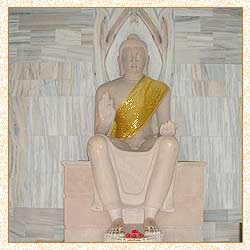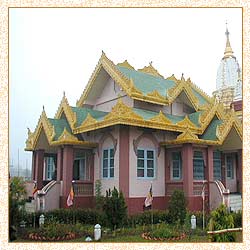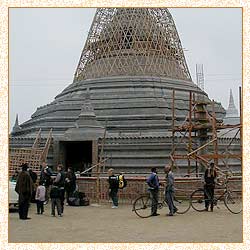

Buddhism evolved in India. There were periods in India's past
when Buddhism was dominant in India. Today less then 1% of India's population is
Buddhist. Buddhism has more followers in countries east of India. Buddhism was
established in about 500 BC. Buddhism began with a prince called Siddhartha
Gautama. Siddhartha belonged to an aristocratic family. As a prince he had lot
of wealth. He never left his palace. At some point Siddharta began to leave his
palace and behold for the first time poverty, sickness and misery. After seeing
this Siddharta lost interest in his spoiled life and left his palace forever and
g ave his rich personal belongings to the needy. He joined a group of ascetics
who were searching for enlightenment. In those days people searching for
enlightenment believed that this could be gained only by people who were capable
of resisting their basic needs. These people almost did not eat anything and
almost starved themselves to death. Siddharta also adopted this path of
searching enlightenment. But at some point he came to a conclusion that this was
neither the way towards enlightenment nor the spoiled life he had as a prince
was the right path towards enlightenment. According to him the right path was
somewhere in the middle and he called it the 'middle path'. In order to focus on
his enlightenment search, Buddha sat under a fig tree and after fighting many
temptations he got his enlightenment. In his region 'enlightened' people were
called Buddha. And so Siddharta was named Buddha. According to Buddha's theory
life is a long suffering. The suffering is caused because of the passions people
desire to accomplish. The more one desires and the less he accomplishes the more
he suffers. People who do not accomplish their desirable passions in their lives
will be born again to this life circle which is full of suffering and so will
distant themselves from the world of no suffering - Nirvana.
ave his rich personal belongings to the needy. He joined a group of ascetics
who were searching for enlightenment. In those days people searching for
enlightenment believed that this could be gained only by people who were capable
of resisting their basic needs. These people almost did not eat anything and
almost starved themselves to death. Siddharta also adopted this path of
searching enlightenment. But at some point he came to a conclusion that this was
neither the way towards enlightenment nor the spoiled life he had as a prince
was the right path towards enlightenment. According to him the right path was
somewhere in the middle and he called it the 'middle path'. In order to focus on
his enlightenment search, Buddha sat under a fig tree and after fighting many
temptations he got his enlightenment. In his region 'enlightened' people were
called Buddha. And so Siddharta was named Buddha. According to Buddha's theory
life is a long suffering. The suffering is caused because of the passions people
desire to accomplish. The more one desires and the less he accomplishes the more
he suffers. People who do not accomplish their desirable passions in their lives
will be born again to this life circle which is full of suffering and so will
distant themselves from the world of no suffering - Nirvana.
To get Nirvana, one has to follow the eight-fold path which are to believe right, desire right, think right, live right, do the right efforts, think the right thoughts, behave right and to do the right meditation. Buddhism emphasis non- violence. Buddha attacked the Brahmanic custom of animal slaughtering during religious ceremonies. Religiously the Buddhists are vegetarians. But many Indians believe that Buddha, died because he ate a sick animal. Buddhism does not have a God. But many Buddhists keep images of Buddha. Buddha is not seen as the first prophet of the religion, but as the fourth prophet of the religion. There are two main doctrines in Buddhism, Mahayana and Hinayana. Mahayana Buddhist believe that the right path of a follower will lead to the redemption of all human beings. The Hinayana believe that each person is responsible for his own fate. Along with these doctrines there are other Buddhist beliefs like 'Zen Buddhism' from Japan and the 'Hindu Tantric Buddhism' from Tibet. Zen Buddhism is a mixture of Buddhism as it arrived from India to Japan and original Japanese beliefs. The Hindu Tantric Buddhism is a mixture of Indian Buddhism and original Tibetian beliefs which existed among the Tibetians before the arrival of Buddhism in Tibet, among it magic, ghosts and tantras (meaningless mystical sentences).
| CHRISTIANITY | HINDUISM | ISLAM | JAINISM | JUDAISM |